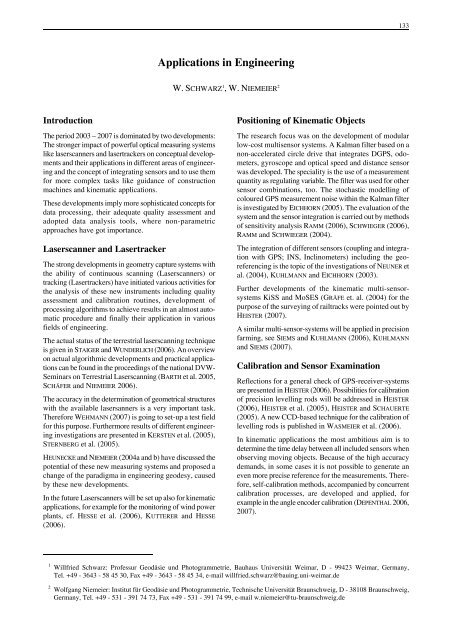NATIONAL REPORT OF THE FEDERAL REPUBLIC OF ... - IAG Office
NATIONAL REPORT OF THE FEDERAL REPUBLIC OF ... - IAG Office
NATIONAL REPORT OF THE FEDERAL REPUBLIC OF ... - IAG Office
Create successful ePaper yourself
Turn your PDF publications into a flip-book with our unique Google optimized e-Paper software.
Introduction<br />
The period 2003 – 2007 is dominated by two developments:<br />
The stronger impact of powerful optical measuring systems<br />
like laserscanners and lasertrackers on conceptual developments<br />
and their applications in different areas of engineering<br />
and the concept of integrating sensors and to use them<br />
for more complex tasks like guidance of construction<br />
machines and kinematic applications.<br />
These developments imply more sophisticated concepts for<br />
data processing, their adequate quality assessment and<br />
adopted data analysis tools, where non-parametric<br />
approaches have got importance.<br />
Laserscanner and Lasertracker<br />
The strong developments in geometry capture systems with<br />
the ability of continuous scanning (Laserscanners) or<br />
tracking (Lasertrackers) have initiated various activities for<br />
the analysis of these new instruments including quality<br />
assessment and calibration routines, development of<br />
processing algorithms to achieve results in an almost automatic<br />
procedure and finally their application in various<br />
fields of engineering.<br />
The actual status of the terrestrial laserscanning technique<br />
is given in STAIGER and WUNDERLICH (2006). An overview<br />
on actual algorithmic developments and practical applications<br />
can be found in the proceedings of the national DVW-<br />
Seminars on Terrestrial Laserscanning (BARTH et al. 2005,<br />
SCHÄFER and NIEMEIER 2006).<br />
The accuracy in the determination of geometrical structures<br />
with the available lasersanners is a very important task.<br />
Therefore WEHMANN (2007) is going to set-up a test field<br />
for this purpose. Furthermore results of different engineering<br />
investigations are presented in KERSTEN et al. (2005),<br />
STERNBERG et al. (2005).<br />
HEUNECKE and NIEMEIER (2004a and b) have discussed the<br />
potential of these new measuring systems and proposed a<br />
change of the paradigma in engineering geodesy, caused<br />
by these new developments.<br />
In the future Laserscanners will be set up also for kinematic<br />
applications, for example for the monitoring of wind power<br />
plants, cf. HESSE et al. (2006), KUTTERER and HESSE<br />
(2006).<br />
Applications in Engineering<br />
W. SCHWARZ 1 , W. NIEMEIER 2<br />
Positioning of Kinematic Objects<br />
1 Willfried Schwarz: Professur Geodäsie und Photogrammetrie, Bauhaus Universität Weimar, D - 99423 Weimar, Germany,<br />
Tel. +49 - 3643 - 58 45 30, Fax +49 - 3643 - 58 45 34, e-mail willfried.schwarz@bauing.uni-weimar.de<br />
2 Wolfgang Niemeier: Institut für Geodäsie und Photogrammetrie, Technische Universität Braunschweig, D - 38108 Braunschweig,<br />
Germany, Tel. +49 - 531 - 391 74 73, Fax +49 - 531 - 391 74 99, e-mail w.niemeier@tu-braunschweig.de<br />
133<br />
The research focus was on the development of modular<br />
low-cost multisensor systems. A Kalman filter based on a<br />
non-accelerated circle drive that integrates DGPS, odometers,<br />
gyroscope and optical speed and distance sensor<br />
was developed. The speciality is the use of a measurement<br />
quantity as regulating variable. The filter was used for other<br />
sensor combinations, too. The stochastic modelling of<br />
coloured GPS measurement noise within the Kalman filter<br />
is investigated by EICHHORN (2005). The evaluation of the<br />
system and the sensor integration is carried out by methods<br />
of sensitivity analysis RAMM (2006), SCHWIEGER (2006),<br />
RAMM and SCHWIEGER (2004).<br />
The integration of different sensors (coupling and integration<br />
with GPS; INS, Inclinometers) including the georeferencing<br />
is the topic of the investigations of NEUNER et<br />
al. (2004), KUHLMANN and EICHHORN (2003).<br />
Further developments of the kinematic multi-sensorsystems<br />
KiSS and MoSES (GRÄFE et. al. (2004) for the<br />
purpose of the surveying of railtracks were pointed out by<br />
HEISTER (2007).<br />
A similar multi-sensor-systems will be applied in precision<br />
farming, see SIEMS and KUHLMANN (2006), KUHLMANN<br />
and SIEMS (2007).<br />
Calibration and Sensor Examination<br />
Reflections for a general check of GPS-receiver-systems<br />
are presented in HEISTER (2006). Possibilities for calibration<br />
of precision levelling rods will be addressed in HEISTER<br />
(2006), HEISTER et al. (2005), HEISTER and SCHAUERTE<br />
(2005). A new CCD-based technique for the calibration of<br />
levelling rods is published in WASMEIER et al. (2006).<br />
In kinematic applications the most ambitious aim is to<br />
determine the time delay between all included sensors when<br />
observing moving objects. Because of the high accuracy<br />
demands, in some cases it is not possible to generate an<br />
even more precise reference for the measurements. Therefore,<br />
self-calibration methods, accompanied by concurrent<br />
calibration processes, are developed and applied, for<br />
example in the angle encoder calibration (DEPENTHAL 2006,<br />
2007).











